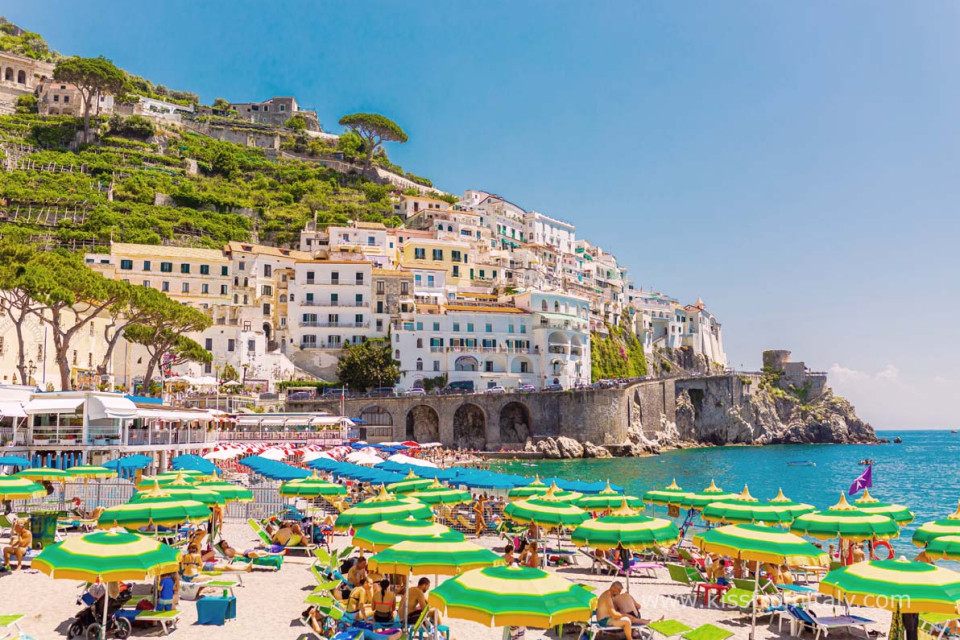
What is Capri's Blue Grotto and How to Visit
Arguably the most picturesque and visited location in Campania, the island of Capri boasts a unique beauty rich in ancient history. Famed for its breathtaking landscapes, upscale beach towns and natural treasures, the island has stood as a popular resort since the time of the Roman republic, and continues to astound its visitors year after year.
The inspiration for countless writers and travellers throughout the centuries, the mythical charm of Capri is best experienced by sea; and what better boat journey to take than to the most famous and spectacular place on the island, the Grotta Azzurra (Blue Grotto).
What is the Blue Grotto
It's a place that has to be seen to be believed: a dark cavern where the sea glows a vibrant electric blue, the cave's jaw dropping appearance and mesmerizing history make it an undeniable tourist spot. Yet, despite its popularity, it nonetheless offers a rare and authentic magic that is impossible to capture.
The intense blue of the crystal water was formed over the millenniums by the erosive action of the sea, whereby sunlight passes through an underwater cave. Entered through a narrow opening in the cliff face, this vast vault (measuring at around 70 metres long and 25 metres wide) offers an unworldly experience for all who enter. An aqua fire gleams from below, lighting up every surface, before leading you through the maze of the grotto. Three connecting branches take visitors to the Sala dei Nomi (the room of names – named after the graffiti signatures left by guests over the centuries), with two deeper passages still into the island before it becomes inaccessible.
Gallery
Can you swim in the Blue Grotto?
You are not allowed to swim in the Blue Grotto and you cannot jump-off the rwa boat when you are inside the cave. However after the closing time some people get in to swim (and it's considered to be an amazing experience!)
What is the History of the Blue Grotto?
Dating back to the Roman era, the Grotto once stood as a personal swimming hole for Emperor Tiberius, whom moved the capitol of the Roman empire to the island in 27AD. It is said that it was used as a marine nymphaeum, decorated with opulent statues and a lavish resting area around the edge. For centuries, locals would fear the Grotto (and did so for time to come), believing it to be inhabited by monsters and spirits who would set a curse on anyone who entered its fortress.
The Grotto was rediscovered in 1826 by German poet, August Kopisch, who would go on to write about it in his book Entdeckung der Blauen Grotte. It then swiftly became a prominent part of the Victorian era grand tours, setting it up for its lifetime of fascination.
In 1964, three statues of the sea gods Neptune and Triton were recovered from the floor (which now feature in a museum in Anacapri), with seven further statue bases discovered in 2009. It is said there may be even more statues still hidden in the sandy depths.
Now the grotto stands as a gleaming gem in Italy's Gulf of Naples. When floating through the many magical twists and turns, it is difficult to believe this is a place not out of a storybook. Its exquisite rapture both enthrals and overwhelms, leaving a mark that will last for life.
Do you need to pay to see the Blue Grotto?
Yes. Tickets cost €13 from the floating ticket office (€9 for the rowboat plus €4 for entry). Entrance is free for children younger than 18. For EU between 18 and 25 years of age, there is a discount of 50% on the entry ticket, so the total cost is €11 (€9 rowboat plus €2 entry). The first Sunday of each month the entrance of Blue Grotto is free, only the boat service must be paid.
There is no minimum age to visit the Blue Grotto, though the use of rowboats to gain access to the cave can be hard on small children and infants, as there is often a long wait under the sun (which can reach an hour during high season at peak times of day).
When is best to see the Blue Grotto?
To experience the grotto at its most vibrant, visit during the the midday hours of noon to 2:00pm when the sun of highest strength. It is advisable to avoid visiting the grotto on overcast days, when the internal glow will be less dramatic.
In case of high winds or rough seas, it is not possible to enter the Blue Grotto and the cave can close and reopen in the same day, according to the weather. To find out if the grotto is closed at any given time, call the Motoscafisti di Capri pier on +39 081 837 5646.
How can I visit the Blue Grotto?
Capri and the Bue Grotto can be easily reached by boat from Capri, Sorrento, Amalfi, Positano, Naples and other ports on the coast of Campania.
We can help you discover the Blue Grotto with a private yacht tour from Sorrento, Naples or the Amalfi Coast. If you have questions about the Grotta Azzurra of Capri (Blue Grotto cave) contact us.







